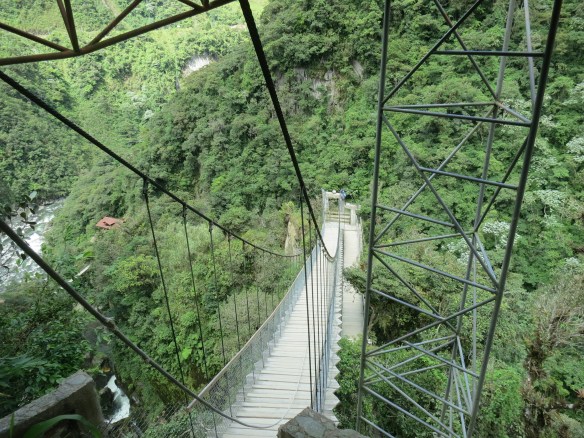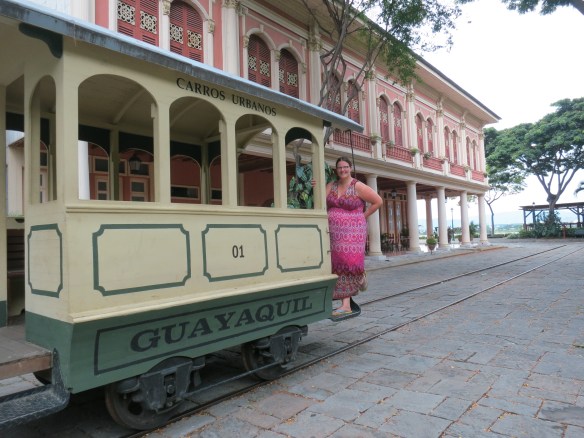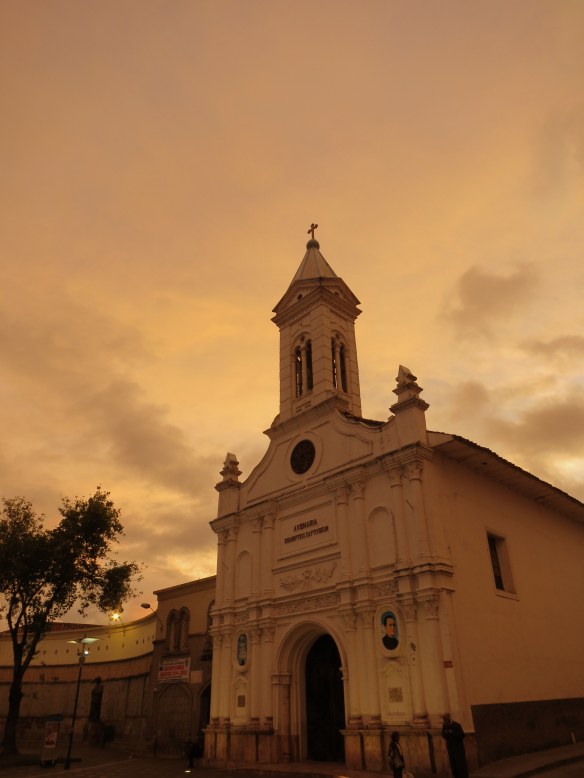Category Archives: Ecuador
Sunrise, Sunset
Image
Where in the World Wednesday
Image
Ecuador by the Numbers
Hours spent in Spanish class–my first classroom experience in a decade: 40
Hours spent valiantly struggling to make conversation with my host mother in Quito: 20
Iguanas encountered: 12
Delicious soups consumed: 20
Waterfalls admired: 8
Ankles sprained: 1
Inca ruins visited: 1
Equatorial lines straddled: 1
Waves dived in: hundreds
Presidential palaces toured: 1
Chicago Bulls paraphernalia seen: countless items
Total days spent in Ecuador: 47
Total money spent: $2,663.25
Average per day: $56.66
Total money spent, minus the airfare: $1,983.25
Average per day, minus the airfare: $42.20
Blissful beach and waterfall moments experienced: many
Foods of Ecuador, Part 2
Way back when I was still in Ecuador, I posted photos of some of the delicious foods I had while there. Here are some more. Unfortunately, I’ve forgotten most of the names of these, so join in if you recognize a dish.
Not Your Typical Party Bus in Baños
I appreciate that the traditional way to get to a waterfall is to hike to it, but when I was in Baños, Ecuador, I discovered another way: party bus. There’s a series of waterfalls along Rio Pastaza just outside of town. You can bike it, but if you are still suffering from a sprained ankle in pursuit of a different set of waterfalls, for example, that option becomes less appealing. So you can take a chiva instead.
“Chiva” means “goat” in Spanish, and in several Latin American countries, it’s the nickname given to party buses: covered, open-sided trucks outfitted with disco balls and massive sound systems. The chivas used for the waterfalls tours are equipped with rows of benches, too. I joined a few other tourists and we enjoyed the bizarre experience of being blasted with loud salsa music in the early afternoon as we sped along a two-lane highway.
Of course, the guide talked in Spanish, so I only understood a little, but frankly, you don’t need to understand words to appreciate a waterfall. We went in a cable car that zipped us across a ravine, to the edge of two waterfalls, which tumbled into the river below as we swung on the cable above. Party bus and then cable car door-to-door service–there are lots of ways to get to a waterfall.
After an interlude wherein the guide wheedled and cajoled to get us all to go on his friend’s zipline, we carried on to the final stop. Here, we had a twenty-minute walk along a beautiful path, down a tricky bit of hill, to a wooden bridge. This was a serious bridge–it was so steep, you had to hold on to a rope anchored to the shore, and use it to walk midway down the bridge. The bridge swayed in the breeze, but once you held on to the sides to steady yourself, you could look around and appreciate the biggest waterfall of the day, roaring down the side of the nearby hill.
The music on the ride back into town was just as loud as the ride out had been, although now we were all pumped up from seeing the waterfalls, we were more ready to groove along. Baños–the only place I’ve been where you can reggaeton your way to a natural wonder.
Beach Time in Ecuador
One of the great pleasures of long-term solo travel is the ability to change plans on a whim. I booked two nights in a small beach hostel in Ecuador, but it turned out to be so close to my platonic ideal of a beach experience, that I stayed for two weeks.
My days followed a pattern: I got up sometime before 10am, ate the best breakfast I had in South America (eggs! warm rolls!), jumped in the waves in the sea, sunbathed, read my book, wrote a blog post, chatted with my new friend Hannah (who was doing a Workaway stint there), snacked, hopped back in the ocean or in the pool, drank a beer while watching the sun set, ate a communal dinner with other hostel guests, chatted and read til bedtime.
Re-reading that paragraph, I’m wondering why I ever left.

Walking the beach at night, you’d feel little crabs skitter over your feet, and occasionally, the big guys, like this one
It was a short walk to the tiny town of Las Tunas, but for groceries or laundry, you needed to catch the hourly bus into Puerto Lopez, about a twenty-minute ride north. I did that run a few times, but after awhile, when I had the basics for my groceries and wore just my swimsuit and one dress in rotation, I stayed at the beach. If other guests were going into town, I’d ask them to pick something up for me, like a pack of tortillas or a few pieces of fruit. I thought that was all right, but near the end of my stay there, Hannah was asking me if I ever intended to do my own shopping again. I suppose that’s a good sign it’s time to move on.
Guayaquil: Ecuador’s Overlooked City
The port town of Guayaquil is the largest city in Ecuador, and it’s one of the oldest cities as well. It’s been the site of many a battle through the years, including skirmishes with pirates and fights for independence from Spain. This contributes to the rough and ready reputation the city and its citizens have, and most people I met there were half-proud, half-sheepish about that reputation. Sure, it doesn’t have the polish of Cuenca or the political importance of Quito, but people from Guayaquil wouldn’t want to be from anywhere else.
El malecon is a revamped stretch of waterfront, a long, rather sterile boardwalk containing statues of past leaders, a botanic garden, a children’s play area, a couple restaurants, and a large clock tower. I liked the part of the walkway built to resemble sails of a ship, and the odd sculptures representing the four elements. The climate of Guayaquil is perfect for the botanic gardens, which sagged with the weight of giant green leaves and bright flowers in the humid heat.
Over a hundred years ago, some iguanas made the plaza in front of the cathedral their home, and since then, it’s unofficially been known as the iguana plaza. There are signs everywhere asking people not to touch the animals, which were roundly ignored by most visitors to the plaza. I did have to watch my step in there–most of the iguanas lounge on the fenced-off areas, but a few decide to leisurely move to another grassy knoll, usually stopping in the middle of the pathway for reasons known only to them. I’m used to seeing pigeons or squirrels take over a public area, but this was the first time I’d seen reptiles be the local pest.
My friend Andy, a native of the city, took me to the Parque Historical, which is a combination outdoor museum and zoo. The zoo area was closed when we visited (the animals are given a day of rest every week, which I think is great), but we were able to see the outside of the hacienda and the reconstructed villagers’ house on stilts. Behind the stilt house, we watched pigs rooting around in their feed and ducks splashing in water. Andy showed me the cocoa beans, which have to be dried in the sun before they’re ground up and used for chocolate. He identified a lot of plants for me, which I always find impressive, as I can maybe name five plants native to my home.
Finally, I spent a little time in Las Peñas. This is the oldest part of the city, a collection of colorful buildings on a hilltop at the end of el malecon. As is true in formerly rough waterfront areas in just about every city I’ve been to, the city leaders have put a lot of money into cleaning it up and bringing tourists in. I didn’t get to experience the nightlife there, but it’s meant to be really fun. As it was, I bought some souvenirs at the large artisan’s market and walked down the oldest street in town (cobblestoned, of course).
A lot of people, myself included, use Guayaquil as just a stopover on their way to other places, but from what I’ve seen, it’s worth spending more time there and exploring the place that claims so many proud residents–not to mention noble iguanas.
Sunrise, Sunset
Image
Cuenca Houses of Worship in Ruins and in Splendor
Like every other place in the conquered Inca empire, Cuenca shows the the effects of the Spanish: the Inca buildings were torn down and the materials used to build the Europeans’ civic buildings and churches. However, in Cuenca, the foundation stones of the Inca buildings are well-preserved enough that we can get a good sense of the size and function of the complex.
It was a palace, comprised of soldiers’ barracks, quarters for virgins dedicated to the sun god, a temple, farming terraces, and other structures necessary to support a center of Inca activity. The ruins were excavated by a team led by Max Uhle, the German archaeologist, from 1919 to 1923. The ruins nowadays include a reconstruction of gardens, down the hill from the main structures, an aviary, and, naturally, a snack stand.
As with every other major Inca structure, the ruins of Pumapungo (“gate of the puma”) are situated precisely on the compass rose, aligned with mountains and other natural formations of spiritual significance. From atop the hill, looking out over the river curving around the base of the ruins, it’s easy to see why this might be a strategic as well as inspirational spot to set up a major hub in your expanding empire.
The ruins are behind the Banco Central and the Museo Pumpapungo, so after touring the ruins and feeling the first hint of rain on my jacket, I went inside the museum. I bypassed the display on money and went to the side room display on the Incas. It was an odd mix of meticulously made costumes and empty display cases, and I only got a muddled sense of the people who lived and died here 600 years ago.

Photos weren’t allowed in the museum, so I just snuck a couple, like this one, showing the Incas worshiping
Upstairs, a much better display awaited me–an entire floor devoted to the different ethnic groups of Ecuador, from the jungle-dwelling people in the Oriente, to the various highlands groups in the Andes, to the people living along the coast. Musical instruments, masks used for celebrations, clothing worn to indicate status, and everyday work tools were the most frequently displayed items.
Finally, one small, dark room at the end of the hall showed the famous shrunken heads of the Shuar people of the Amazon jungle. (Head shrinking was outlawed a few decades ago, so now they can only shrink the heads of animals, like sloths.) This is the only exhibit in the museum to include English translations alongside the Spanish placards, and the display includes a lot of information on the Shuar people in general, before getting to the head-shrinking. A few shrunken heads were on display, and they were eerie and grotesque, as you might expect.
But my favorite part of the exhibit was the careful way the text explained why the Shuar did this–to make sure the soul of the deceased, contained in the head, could not return–and that it wasn’t always done to enemies, but sometimes to Shuar people who had killed. Killing was so taboo that the killer was himself put to death and his head shrunk so his tainted spirit couldn’t return and inhabit another person. That’s a very different thing from the bloodthirsty savage we likely all imagined, right?
The final placard of the exhibit made this plea: “The ‘Shuar’ are a people who merit respect, and even if many of their customs have changed for diverse reasons, they maintain themselves as a group proud of their past and of their present, a true example of the diverse ethnic communities of Ecuador. Because being ‘civilized’ does not imply casting aside the historic and cultural baggage from which our being originates.” That’s a major statement for a group to make in Ecuador, where indigenous groups were until very recently legally discriminated against, and are still struggling against the racism of city-dwelling Ecuadorians. I was impressed to see the statement made here.
I was in Cuenca during the last two days of Carnaval, and the city was a ghost town, which meant I spent a lot of my time taking photos of street art and wandering empty streets, dodging small children with foam cans. It also meant that all the churches were closed, so I didn’t really get to go inside any, but here are a few shots of the exteriors.
The New Cathedral was a boring brown brick building, but the doors and the domes were great. Apparently, the interior has a lot going for it. I’ll have to check it out during a non-holiday sometime.

























































